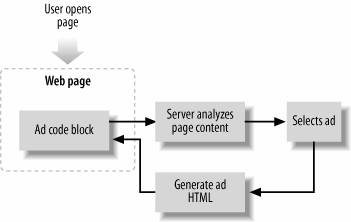Section 5.2. Understanding Contextual Relevance
5.2. Understanding Contextual RelevanceThe basis of CPC advertising is having visitors to your web site click the links presented to them by ads. People are likely to notice ads, and click on ad links, only if the content of the ad is relevant to their current interests. This leads to the notion of contextually relevant advertising (usually referred to simply as contextual advertising) often being confused with CPC advertising, even though the two are not the same.
5.2.1. Serving AdsHow are ads placed on contextually relevant pages? As you can imagine, it isn't done by a roomful of gnomes scanning web pages and deciding what ads should go on them. There are simply too many web sites and web pages, and their content changes too quickly, for this to work (even if you had a few gnomes).
Obviously, software, not gnomes, is used to automatically analyze the content of a web page to determine its content and which contextually relevant ads should be placed on it. This is fortunate for Google (and other search engine companies) because determining the content of a site for contextual ad relevancy is essentially the same task as determining the content of a site to match with the keywords used in a search.
Here's generally how the process of placing a contextually relevant CPC ad on your site works:
These logistics behind serving contextual ads are shown in Figure 5-1. Figure 5-1. The program that generates the contextual ads figures out which ads are relevant and generates the HTML to display them on your web page 5.2.2. Dollars and CentsThe amount of money generated by an individual click on a contextual ad is a highly variable and murky business. In the case of Google and other contextual programs, the amount that is paid for an ad depends on an automated bidding process where advertisers bid for keywords. So the amount paid for a contextual ad varies day-by-day and even hour-by-hour.
Essentially, a contextual ad program such as Google is acting as an agent or a broker: ads are sold by keyword to advertisers and publishers are paid on the basis of click throughs (see Chapter 7 for the details of Google's role as a broker). But Google doesn't say what percentage commission it takes, or what share of the pie it leaves for you, the web publisher. If you sign up for Google's AdSense, the leading contextual ad program, you just have to take what Google gives you, and trust Google.
An individual click on a contextual ad is not going to make you rich. The net value to a web publisher of a click ranges from one or two pennies to a few dollars at the very high end. The average click is probably worth about $0.20. Combine this statistic with the fact that the click-through rates (the clicks an ad gets divided by the number of times it is served) are in the low single-digit percentages2% is a quite respectable CTRand you come up with the fact that to make good money from CPC, you need a lot of traffic. A six-figure income from CPC contextual advertising is not unheard of, but it takes monthly page views in the millions. Doing the math, this page-view volume implies either a broad site or some highly trafficked pages (or both). Supposing you have a great deal of contentsay 10,000 pagesit's possible to reach the target volume of more than 100,000 page views per month with an average of 10 page views per page per monthambitious, in terms of the amount of content, but not impossible, and quite modest in terms of the traffic per page. These 100,000 page views per month might theoretically give you an income of around $400 a month calculated by multiplying 100,000 times the 2% CTR, times the $0.20 average fee per click. Of course, most sites are created to fulfill multiple needs and use a variety of mechanisms to generate income. But if your only consideration is creating revenue using a contextual CPC model, you should consider whether it makes more sense to get to 100,000 page views and beyond by creating a relatively few heavily visited pagesthe shallow-site approachor a great many, less trafficked pagesthe broad-site approach . If you take the broad-site approach, then you'll need to figure out a low-cost way to generate the content. The calculation that shows a $400 monthly revenue for a 10,000-page sitea broad site that is not heavily traffickedimplies a revenue stream of about $0.50 a page per year. For this to make sense as a business proposition, it can't cost you very much to generate this content (perhaps because you create it yourself). Business modeling is only as good as its assumptions. If the hypothetical 10,000-page site averages 100 views per page rather than 10 views per pagenot at all unreasonable for a worthwhile sitethen the economics shift radically in favor of the site publisher. The site is now probably generating $50,000 or so annually in CPC contextual revenue (each page contributes an average of $5.00). The point here is to understand the implications of site and advertising metrics on the economics of your site so you can take the steps required to meet your financial goals.
|
EAN: 2147483647
Pages: 145
